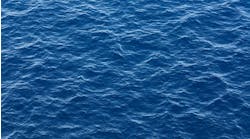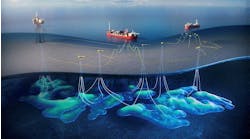Gullfaks set for 20 more years
Gullfaks, one of Norway’s mainstay oilfields, has been in production for 20 years, delivering over 2 Bbbl of oil. Operator Statoil recently drilled the field’s 50th exploration well, and is banking on new discoveries to extend productivity by a further two decades.
At ONS Stavanger, Lars Christian Bacher, senior VP for exploration and production in the Tampen area, outlined the company’s thinking. To date, he said, the partners have invested NOK500 billion on the development, achieving a recovery factor of 55%. New measures to sustain output from Gullfaks and associated fields include first-time use of subsea separation (Tordis IOR), and the tying in of the Skinfaks/Rimfaks subsea satellites to the Gullfaks platform complex.
The current long-term target is to raise the recovery rate to 69%, partly through more efficient operations. The Tampen management has launched a new program that aims to lower running costs by NOK1 billion by 2010, he said. This would be achieved partly by reduced manning, allowing certain personnel to be relocated to other projects.
Recently, he added, the company had discovered Gimle (25 MMbbl) and two separate oil accumulations from the same well, Epidot and Alun, adding 50 Mbbl to the Gullfaks area inventory. “We have made 10 discoveries from our last seven exploratory wells, with no dry holes.” Next year the partners plan to drill at least six new targets, out of the 50 identified across the license area by Gullfaks’ geologists, following a challenge issued by management four years ago to unearth new prospects and leads.
Also at ONS, Statoil confirmed that the Gjoa license partners plan to use a semisubmersible for this new development project, due onstream in 2010. Their latest scheme, which first has to be ratified by the Ministry of Petroleum and Energy, involves drilling four subsea gas and eight to 10 subsea oil wells, with the gas sent to the UK market via the Flags trunkline system.
Gjoa is situated in blocks 35/9 and 36/7, 70-km north-west of Troll. Flow assurance issues, including waxy crude, pose questions of marginality, with reserves estimated at 60 MMbbl of oil and 35 bcm of gas. But the economics perk up when factoring in supplies from three Hydro-operated oil and gas accumulations 30 km west of Gjoa, Belinda, Camilla and Fram B. Under the proposed plan, all three will be linked by flowlines, with the commingled wellstream directed to the Gjoa semi via an insulated carbon steel pipeline.
ConocoPhillips scores west of Judy
ConocoPhillips has confirmed a new mid-size gas condensate discovery in the UK Central North Sea, 9 km west of its Judy/Joanne production complex. The original exploration well in block 30/6 was drilled early this year, in 265 ft of water. An immediate sidetrack, drilled to a total depth of 16,000 ft, revealed a gross hydrocarbon column of over 2,000 ft within Triassic Joanne sandstone. Partner BG Group estimated reserves at 100-275 MMbbl, which would make this the largest new mid-depth UK discovery since PanCanadian’s Buzzard.
In the Norwegian sector of the North Sea, work was recently completed on a new pipeline, as part of ConocoPhillips’ Ekofisk 2/4 Bravo FTP bypass project. The new stainless steel line, a 2.8-km bundle manufactured and installed by Subsea 7, was designed to replace two existing oil and gas export lines between the 2/4 B and 2/4 FTR platforms. The bypass project also involves re-routing production from 2/4 FTP to the newly installed 2/4 M facility.
Ireland opens up western waters
Ireland’s Ministry for Communications, Marine and Natural Resources has issued new exploration licenses to six companies, covering acreage off the west coast in the Slyne, Erris and Donegal basins. Most of the successful applicants were already active in these waters - only one bidder, Grianan Energy, was rejected for failing to comply with conditions specified in the licensing round.
Awards went to four different consortia. Of these, Statoil and Shell picked up two blocks, and one part-block close to the Corrib gas field, currently undergoing a subsea-shore development. Island Oil & Gas will operate the Inishowen license, in partnership with Sweden’s Lundin Exploration and Endeavour Energy, which comprises five part-blocks east of Shell’s undeveloped Rockall basin gas-condensate find. Lundin and Island also secured 50% each of two blocks and two part-blocks in the southern Slyne trough, which they plan to address initially via a 3D seismic survey.
Canada’s Serica Energy gained 100% of another license in the Slyne basin, 40 km south of Corrib, in water depths of 200-300 m. The acreage is already covered by modern 3D seismic. Serica plans to re-process around 300 sq km of the data, focusing on prospects in Triassic Sherwood and Mid-Jurassic sandstones.
Irish Energy Minister Noel Dempsey said he hoped the awards would lead to discovery of new hydrocarbon resources that would reduce Ireland’s dependence on imported energy. He also announced that the country’s next licensing round would be directed at the gas-prone Porcupine basin - details were due to be issued this month.
In an attempt to attract more new players, the Petroleum Affairs Division has asked UK-based upstream consultancy Hannon Westwood to define the distribution of undiscovered hydrocarbon resources within the country’s various offshore basins. Managing Director Jim Hannon says his company has been asked to include around 600 undrilled prospects and leads west of Ireland in its initial analysis. One side-aim of the study is to promote a new view of the UK and Irish shelves as being linked, in terms of petroleum systems and prospectivity.
Island has led the Irish exploration drilling effort this year, taking the semisubPetrolia on a long-term, multi-well contract. Last month, the company agreed a temporary ‘sub-let’ of the rig to Providence Resources in 2007. Both Providence and Island have various undeveloped interests in the Celtic Sea. Under a separate arrangement, the two companies are to conduct a study which could lead to some form of joint development via a shared floating production facility.
Cameron trees set standard
In the Dutch gas sector, Total has commissioned all-electric Christmas trees from Cameron for two subsea production systems for the K/5-F development. This reported world first will allow K/5-F - 110 km northwest of Den Helder - to be tied in to an existing platform on the K/6-N field via a new 10-km, 8-in. flowline and associated umbilical. Both will be installed in 2007 by Subsea 7. The gas will be treated on the K/6 complex, with production due to start late next year.
Recently, Total also brought onstream the L4G field, which will produce 1MMcm/d at peak. Accommodating supplies from this single-well, subsea development involved extending the deck on the receiving L4A platform; concurrently, Total commissioned a new pipeline between K6GT and K6C to optimize gas production and flow in the K6-L7 area.
Jeremy Beckman, London




